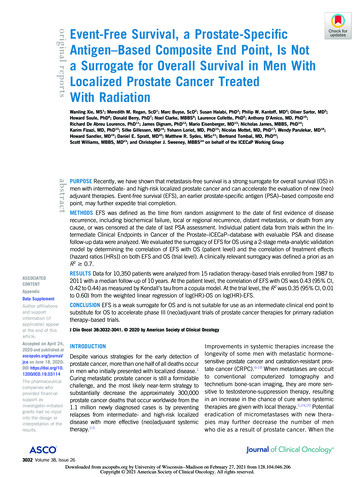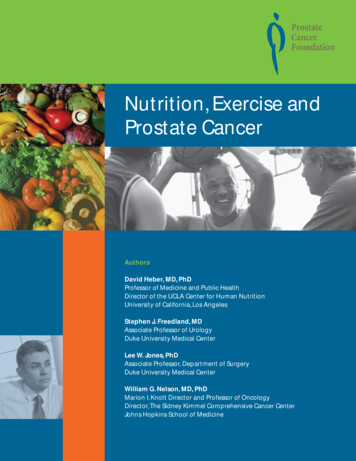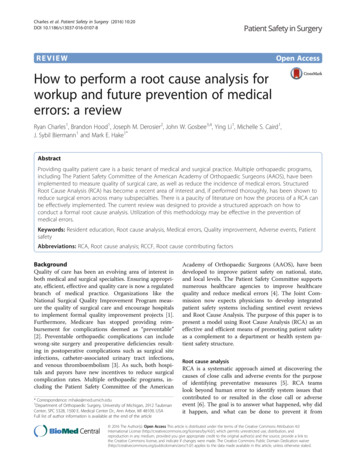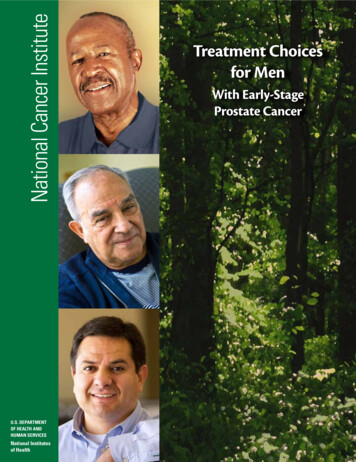
Transcription
original reportsEvent-Free Survival, a Prostate-SpecificAntigen–Based Composite End Point, Is Nota Surrogate for Overall Survival in Men WithLocalized Prostate Cancer TreatedWith RadiationWanling Xie, MS1; Meredith M. Regan, ScD1; Marc Buyse, ScD2; Susan Halabi, PhD3; Philip W. Kantoff, MD4; Oliver Sartor, MD5;Howard Soule, PhD6; Donald Berry, PhD7; Noel Clarke, MBBS8; Laurence Collette, PhD9; Anthony D’Amico, MD, PhD10;Richard De Abreu Lourenco, PhD11; James Dignam, PhD12; Mario Eisenberger, MD13; Nicholas James, MBBS, PhD14;Karim Fizazi, MD, PhD15; Silke Gillessen, MD16; Yohann Loriot, MD, PhD15; Nicolas Mottet, MD, PhD17; Wendy Parulekar, MD18;Howard Sandler, MD19; Daniel E. Spratt, MD20; Matthew R. Sydes, MSc21; Bertrand Tombal, MD, PhD22;Scott Williams, MBBS, MD23; and Christopher J. Sweeney, MBBS24 on behalf of the ICECaP Working GroupabstractPURPOSE Recently, we have shown that metastasis-free survival is a strong surrogate for overall survival (OS) inmen with intermediate- and high-risk localized prostate cancer and can accelerate the evaluation of new (neo)adjuvant therapies. Event-free survival (EFS), an earlier prostate-specific antigen (PSA)–based composite endpoint, may further expedite trial completion.METHODS EFS was defined as the time from random assignment to the date of first evidence of diseaserecurrence, including biochemical failure, local or regional recurrence, distant metastasis, or death from anycause, or was censored at the date of last PSA assessment. Individual patient data from trials within the Intermediate Clinical Endpoints in Cancer of the Prostate–ICECaP–database with evaluable PSA and diseasefollow-up data were analyzed. We evaluated the surrogacy of EFS for OS using a 2-stage meta-analytic validationmodel by determining the correlation of EFS with OS (patient level) and the correlation of treatment effects(hazard ratios [HRs]) on both EFS and OS (trial level). A clinically relevant surrogacy was defined a priori as anR2 0.7.ASSOCIATEDCONTENTAppendixData SupplementRESULTS Data for 10,350 patients were analyzed from 15 radiation therapy–based trials enrolled from 1987 to2011 with a median follow-up of 10 years. At the patient level, the correlation of EFS with OS was 0.43 (95% CI,0.42 to 0.44) as measured by Kendall’s tau from a copula model. At the trial level, the R2 was 0.35 (95% CI, 0.01to 0.60) from the weighted linear regression of log(HR)-OS on log(HR)-EFS.Author affiliationsand supportinformation (ifapplicable) appearat the end of thisarticle.CONCLUSION EFS is a weak surrogate for OS and is not suitable for use as an intermediate clinical end point tosubstitute for OS to accelerate phase III (neo)adjuvant trials of prostate cancer therapies for primary radiationtherapy–based trials.Accepted on April 24,2020 and published atascopubs.org/journal/jco on June 18, 2020:DOI e pharmaceuticalcompanies whoprovided financialsupport asinvestigator-initiatedgrants had no inputinto the design orinterpretation of theresults.J Clin Oncol 38:3032-3041. 2020 by American Society of Clinical OncologyDespite various strategies for the early detection ofprostate cancer, more than one half of all deaths occurin men who initially presented with localized disease.1Curing metastatic prostate cancer is still a formidablechallenge, and the most likely near-term strategy tosubstantially decrease the approximately 300,000prostate cancer deaths that occur worldwide from the1.1 million newly diagnosed cases is by preventingrelapses from intermediate- and high-risk localizeddisease with more effective (neo)adjuvant systemictherapy.2-5Improvements in systemic therapies increase thelongevity of some men with metastatic hormonesensitive prostate cancer and castration-resistant prostate cancer (CRPC).6-18 When metastases are occultto conventional computerized tomography andtechnetium bone-scan imaging, they are more sensitive to testosterone-suppression therapy, resultingin an increase in the chance of cure when systemictherapies are given with local therapy.5,19,20 Potentialeradication of micrometastases with new therapies may further decrease the number of menwho die as a result of prostate cancer. When the3032 Volume 38, Issue 26Downloaded from ascopubs.org by University of Wisconsin--Madison on February 27, 2021 from 128.104.046.206Copyright 2021 American Society of Clinical Oncology. All rights reserved.
PSA is not a Surrogate for OS in Localized Prostate CancerCONTEXTKey ObjectivesTo determine whether event-free survival (EFS), an early prostate-specific antigen (PSA)–based composite end point can beused as an intermediate clinical end point and serve as a surrogate for overall survival (OS) in localized prostate cancer. Ifsurrogacy was established, the secondary objective was to detail how to deploy EFS as an end point to expeditecompletion of randomized phase III clinic trials in this setting.Knowledge GeneratedEFS has very a low correlation with OS in men with localized prostate cancer treated with radiation, and is therefore a weak surrogate for OS.RelevanceUnlike metastasis-free survival, EFS is not suitable for use as an intermediate clinical end point to substitute for OS toaccelerate phase III (neo)adjuvant trials of prostate cancer therapies for primary radiation therapy–based trials. Researchis ongoing and needed to quantify other clinical benefits from preventing a PSA relapse in this setting.quintessential end point of overall survival (OS) is usedas the primary end point, (neo)adjuvant prostate cancerclinical trials usually take longer than a decade to bereported.Recently, the Intermediate Clinical Endpoints in Cancer ofthe Prostate (ICECaP) working group has shown thatmetastasis-free survival (MFS: metastasis on conventionalimaging or death from any cause) is a strong surrogate forOS in localized prostate cancer trials.21 For new treatmentswith an anticipated treatment effect size that will decreasethe rate of metastases by . 33% (ie, hazard ratio [HR], 0.67), MFS as the primary end point can shorten the timeto show an OS benefit.21 Disease-free survival (DFS), whichis MFS plus local-regional recurrence events, is not asstrong a surrogate for OS.Use of an earlier intermediate clinical end point (ICE) including prostate-specific antigen (PSA) recurrence couldresult in even more expeditious adjuvant trial conduct thanDFS or MFS. However, for an ICE to serve as a goodsurrogate for OS, there must be no confounding fromsalvage therapy for relapsed disease that can either curethe disease and/or prolong postrelapse survival to thepoint that competing risks of death affect the analysis.22-27Salvage prostate bed radiation after a prostatectomy andthe prolonged survival of patients treated with androgendeprivation therapy (ADT) for biochemical recurrence(BCR) are potential confounders for prostate canceroutcomes. Prior studies have shown PSA nadir, end oftreatment PSA, time to BCR, and post-BCR PSA doublingtime (PSA-DT), are prognostic for OS and have somesurrogacy at the patient level.28-31 However, to ourknowledge, no prior studies using individual patient data(IPD) from multiple studies have been conducted toassess trial-level surrogacy, which evaluates whethera treatment effect on the ICE (eg, time to BCR) is correlatedwith the treatment effect on the ultimate end point (ie, OS)across many trials.We hypothesized that event-free survival (EFS), which includes all components of DFS plus PSA-only relapse, maybe a surrogate for OS at both the patient and the trial level.We also assessed the surrogacy of EFS for MFS, becauseMFS is a strong surrogate for OS. Given the observation thatmost patients with intermediate- or high-risk localizedprostate cancer are cured, and even if they relapse witha rising PSA, often die as a result of a nonprostate cancerdeath, we also investigated the surrogacy of ICEs fordisease-specific survival (DSS).METHODSTrial Selection CriteriaEligible trials were identified from the established ICECaPdata repository, composed of 22,825 IPD from 28 randomized trials conducted in Australia, Canada, Europe,New Zealand, and the United States for localized prostatecancer.1 For this analysis, eligible trials included radiationtherapy as primary therapy that had evaluable PSA anddisease follow-up data suitable for EFS analysis (see endpoint definitions). Prostatectomy-based trials were not included because of a lack of evaluable PSA data.Definition of End PointsEFS was measured from the date of random assignment tothe date of first evidence of disease recurrence, includingbiochemical failure, local or regional recurrence, distantmetastasis, or death from any cause, or was censored at thedate of last PSA assessment. Death without prior diseaserecurrence was also censored at the last PSA assessment ifthe interval between the last PSA assessment and the dateof death was . 15 months. MFS was measured from thedate of random assignment to the date of the first evidenceof recorded distant metastases or death from any cause, orwas censored at the date of last follow-up. OS was measured from the date of random assignment to death fromany cause and censored at the date of last follow-up inJournal of Clinical OncologyDownloaded from ascopubs.org by University of Wisconsin--Madison on February 27, 2021 from 128.104.046.206Copyright 2021 American Society of Clinical Oncology. All rights reserved.3033
Xie et alB1.00.90.80.70.60.50.40.30.20.1Survival (probability)Survival (probability)AOSMFSNo. (%) of eventsEFSOS: 4,377 (42)MFS: 4,390 (46)EFS: 6,049 DSS: 1,026 (10)TTM: 1,503 (16)TTE: 4,666 (45)010 11 12 13 14 15TTENo. (%) of events12345678910 11 12 13 14 15Time Since Random Assignment (years)Time Since Random Assignment (years)No. at risk:No. at .160.140.120.100.080.060.040.02Hazard FunctionHazard .040.02TTETTMDSS012345678910 11 12 13 14 15Time Since Random Assignment (years)012345678910 11 12 13 14 15Time Since Random Assignment (years)FIG 1. (A) Kaplan-Meier estimates of overall survival (OS), metastasis-free survival (MFS), and event-free survival (EFS) where non–prostate cancer deathswere counted as events. (B) Kaplan-Meier estimates of disease-specific survival (DSS), time to metastasis (TTM), and time to event (TTE) where non–prostatecancer deaths were censored. (C) Estimated hazard functions over time for OS, MFS, and EFS. (D) Estimated hazard functions over time for DSS, TTM, andTTE. Median follow-up was 10 years.surviving patients. Time to event (TTE), time to metastasis(TTM), and DSS were defined analogously to EFS, MFS,and OS, respectively, but patients with nonprostate deathshad end points censored or considered as competing risk insensitivity analyses.Biochemical failure was defined according to the2006 RTOG-ASTRO Phoenix definition. A PSA rise by 2 ng/mL above the nadir was considered biochemicalfailure; patients not fully meeting the PSA criteria for failurewho underwent subsequent therapy were also declared tobe failures at the time of salvage initiation. Of the 15 included trials, 14 trials were viable for harmonization by thePhoenix definition and 1 trial used the ASTRO definition(Data Supplement, online only). Local or regional recurrence was based on trial-defined events; distant metastasis was confirmed by imaging or histologic evidence asdescribed in our prior MFS analysis.21Statistical AnalysesSurrogacy criteria. We evaluated the surrogacy of EFS withOS using a 2-stage meta-analytic validation model as described previously.32 Two conditions must hold to claimEFS is a surrogate for OS. Condition 1 requires EFS and OSto be correlated. Condition 2 requires that the treatmenteffects on both end points be correlated. The validity of thesurrogate is reflected by the strength of both correlations.To be consistent with our previous work and other surrogacy assessments in oncology, we defined a priori a clinically relevant surrogacy as R2 0.7.1,21Condition 1 was tested at both the patient and the trial level.At the patient level, associations of OS with EFS wereevaluated via a bivariate copula model over the entirefollow-up of IPD (Data Supplement). Kendall’s tau (range,0-1) quantified the correlation between end points. At thetrial level, we first obtained Kaplan-Meier estimates of5-year EFS and 8-year OS rates for each treatment armwithin each trial. We then performed weighted linear regression (WLR) of trial- and arm-specific 8-year OS rates on5-year EFS rates. Similar analyses were performed at anearlier milestone time: OS rates at 5 years on EFS rates at3 years. These time points were chosen because they arereported frequently in the literature and reflect the earliertime of biochemical failures. Regressions were weighted by3034 2020 by American Society of Clinical OncologyDownloaded from ascopubs.org by University of Wisconsin--Madison on February 27, 2021 from 128.104.046.206Copyright 2021 American Society of Clinical Oncology. All rights reserved.Volume 38, Issue 26
PSA is not a Surrogate for OS in Localized Prostate CancerB1.01.00.90.90.80.85-Year MFS Rate8-Year OS 30.40.50.60.70.80.91.000.10.20.35-Year EFS Rate0.40.50.60.70.80.91.00.80.91.03-Year EFS RateD1.01.00.90.90.80.85-Year TTM Rate8-Year DSS 30.40.50.60.70.80.91.05-Year TTE Rate00.10.20.30.40.50.60.73-Year TTE RateFIG 2. Bubble plot and regression of (A) overall survival (OS) at 8 years on event-free survival (EFS) at 5 years; (B) metastasis-free survival (MFS) at5 years on EFS at 3 years; (C) disease-specific survival (DSS) at 8 years on time to event (TTE) at 5 years; and (D) time to metastasis (TTM) at 5 yearson TTE at 3 years. All rates were Kaplan-Meier estimates by trial and treatment arm. Circle size and regression were weighted by inverse variance ofthe 5- or 3-year estimate for EFS and TTE.the inverse of variances of the 5- or 3-year estimates of EFS.R2 was used to quantify the proportion of variance that wasexplained by the regressions.Condition 2 was tested at the trial level. Proportional hazards models estimated the study-specific treatment effects(ie, the natural log[HR] of the experimental v the controlarm) on the EFS and OS. We then fit a WLR of log(HR)-OSon log(HR)-EFS across trials. Regressions were weighted byinverse variances of the log(HR)-EFS. The same approachwas applied to the surrogacy analysis of EFS for MFS, andthe surrogacy of TTE for TTM and DSS, where end points ofpatients with nonprostate cancer deaths were censored.Subgroup and sensitivity analysis. We conducted preplanned subgroup analyses by age (, 70 years, 70 years),by duration of ADT (None, 3-8 months, 2 years), by patientrisk groups (defined by the National Comprehensive CancerNetwork [NCCN] or D’Amico’s criteria), and by biochemicalfailure criteria (Phoenix definition only). Because a largeproportion of OS events were non–prostate cancer deaths,we performed sensitivity analyses to estimate the trial-levelcorrelation between cumulative incidence estimates of TTEand DSS, and between the subdistribution treatment effectHR estimates for TTE and DSS from competing risk models,for which non–prostate cancer deaths were considered to bethe competing risk for each end point. Model accuracy wasassessed by the leave-one-out cross validation approach(Data Supplement).Surrogate threshold effect. The surrogate threshold effect(STE) is defined as the minimum treatment effect on thesurrogate (HR-EFS) necessary to predict a significant OSbenefit, corresponding to the upper 95% prediction limit forOS HR lower than 1 (Data Supplement). All analyses wereperformed using SAS 9.4 (SAS Institute, Cary, NC) andR packages.33Journal of Clinical OncologyDownloaded from ascopubs.org by University of Wisconsin--Madison on February 27, 2021 from 128.104.046.206Copyright 2021 American Society of Clinical Oncology. All rights reserved.3035
Xie et alTABLE 1. Surrogacy Condition 1: Correlation Between Clinical End Points (correlation using patient-level data)Correlation Using Patient-Level DataNo. of TrialsNo. of PatientsKendall’s Tau (95% CI)16When non-CaP deaths were counted as eventsCorrelation of OS and EFS10,3500.43 (0.42 to 0.44)a139,4810.51 (0.49 to 0.52)Correlation of DSS and TTE14b9,9340.52 (0.50 to 0.54)Correlation of TTM and TTE13a9,4810.53 (0.51 to 0.55)Correlation of MFS and EFSWhen non-CaP deaths were censoredAbbreviations: CaP, cancer of the prostate; DSS, disease-specific survival; EFS, event-free survival; MFS, metastasis-free survival; OS, overallsurvival; TTE, time to event; TTM, time to metastasis.aExcluding 3 studies that did not collect metastasis data.bExcluding 2 studies with , 3 prostate cancer deaths.RESULTSTrial and Patient CharacteristicsFor analysis, 10,350 patients from 15 primary radiationtherapy–based trials were included (Data Supplement).One trial was split into 2 experimental arms, which resultedin 16 study units for EFS and OS analysis and 13 study unitsfor MFS analysis (Data Supplement). Most trials comparedthe duration of ADT (10 trials) or different radiation doses orfields (4 trials). Patients enrolled in the trials from 1987 to2011, and the median follow-up was 10 years (range, 0.122 years). More than 80% of patients were , 75 years ofage, and nearly 60% had high-risk disease according to theNCCN or D’Amico criteria (Data Supplement).For the EFS end point, 6,049 events were reported, 4,666(77%) from disease recurrence (biochemical failure only56%; the following were with or without reported biochemical failure: local or regional recurrence, 12%; distantmetastasis, 6%; and unknown recurrence site, 3%) and23% from nonprostate cancer death (Data Supplement). Themedian duration of EFS from random assignment was6.0 years (95% CI, 5.9 to 6.2 years). There were 4,390 eventsfor the MFS end point: 29% metastasis, 5% prostate cancerdeath without recoded metastasis, and 66% non–prostatecancer death. Observed 5-year rates from the Kaplan-Meiercurves were 56% (95% CI, 55% to 57%) for EFS,80% (95% CI, 79% to 81%) for MFS, and 84% (95% CI,84% to 85%) for OS (Fig 1). Cumulative event rates for diseaserecurrence, metastasis, and prostate cancer death comparedwith non–prostate cancer death were delineated for the overallcohort and by the NCCN risk group and age group (DataSupplement). For patients who experienced an EFS diseaserecurrence event (n 5 4,666 of the 6,049 events), medianpostrecurrence OS was 7.4 years (95% CI, 7.1 to 7.7years). For patients who were reported to have a metastasis(n 5 1,287 of 4,390 MFS events), median postmetastasissurvival was 1.9 years (95% CI, 1.8 to 2.1 years).Surrogacy Condition 1: Correlation Between ICE and OSAt the patient level, the Kendall’s tau correlation over the entirefollow-up was 0.43 (95% CI, 0.42 to 0.44) for EFS with OS and0.51 (95% CI, 0.49 to 0.52) for EFS with MFS. When non–prostate cancer deaths were censored, the correlations of TTETABLE 2. Surrogacy Condition 1: Correlation Between Clinical End Points (regression using trial level estimates)Regression Using Trial-Level EstimatesNo. of TrialsNo. of Arms14b28R2 (95% CI)When non-CaP deaths were counted as events8-year OS rate on 5-year EFS ratea,b0.55 (0.26 to 0.70)8-year MFS rate on 5-year EFS rate11220.63 (0.31 to 0.76)5-year OS rate on 3-year EFS rate16320.61 (0.35 to 0.73)5-year MFS rate on 3-year EFS rate13a260.73 (0.48 to 0.82)8-year DSS on 5-year TTE rate14b280.45 (0.15 to 0.63)8-year TTM on 5-year TTE rate11a,b220.49 (0.15 to 0.67)5-year DSS on 3-year TTE rate16320.44 (0.17 to 0.62)260.57 (0.27 to 0.72)When non-CaP deaths were censored5-year TTM on 3-year TTE ratea13Abbreviations: CaP, cancer of the prostate; DSS, disease-specific survival; EFS, event-free survival; MFS, metastasis-free survival; OS, overallsurvival; TTE, time to event; TTM, time to metastasis.aExcluding 3 studies that did not collect metastasis data.bExcluding 2 studies with median follow-up of , 6 years.3036 2020 by American Society of Clinical OncologyDownloaded from ascopubs.org by University of Wisconsin--Madison on February 27, 2021 from 128.104.046.206Copyright 2021 American Society of Clinical Oncology. All rights reserved.Volume 38, Issue 26
PSA is not a Surrogate for OS in Localized Prostate Cancerwith DSS and with TTM were 0.52 (95% CI, 0.50 to 0.54) and0.53 (95% CI, 0.51 to 0.55), respectively.(Data Supplement) and in leave-one-out cross-validation(Data Supplement).The end point correlation was also tested using trial-levelestimates (Fig 2). The R2 was 0.55 (95% CI, 0.26 to 0.70)from WLR of 8-year OS on 5-year EFS rates and was 0.63(95% CI, 0.31 to 0.76) of 8-year MFS on 5-year EFS ratesacross trials and treatment arms. With earlier milestonetime points of 5-year OS and MFS rates versus 3-year EFSrates, R2 was 0.61 (95% CI, 0.35 to 0.73) and 0.73(95% CI, 0.48 to 0.82), respectively. Tables 1 and 2 alsosummarize R2 for these end points when non–prostatecancer deaths were censored.STESurrogacy Condition 2: Correlation Between TreatmentEffect on ICE and OSThis work clearly shows that EFS is a weak surrogate forboth OS and DSS for men with intermediate- and high-risklocalized prostate cancer treated with curative-intent radiation with a 10% chance of dying as a result of prostatecancer and approximately a 60% OS at 10 years. Notably,this analysis included only patients treated with primaryradiation, and therefore, the findings should not be extrapolated to trials of patients treated with prostatectomy orsalvage radiation after prostatectomy26. As the estimatedhazard curves over time (Fig 1) depict, there are many earlyEFS events (mostly PSA relapses) with few MFS and OSevents. This indicates that despite 80% of men beingyounger than 75 years old and fit for a clinical trial, they arestill more likely to die a non–prostate cancer death even ifthey have a PSA relapse. This provides additional evidencethat many PSA relapses are indolent and/or are controlledby testosterone suppression.34,35At the trial level, trial-specific treatment effects, measuredby log-HR for each end point, are shown in forest plots inthe Data Supplement. The R2 from the WLR of log(HR)-OSon log(HR)-EFS was 0.35 (95% CI, 0.01 to 0.60) and was0.55 (95% CI, 0.09 to 0.74) for log(HR)-MFS on log(HR)EFS (Table 3). When non–prostate cancer deaths werecensored, the R2 of log(HR)-DSS on log(HR)-TTE was 0.39(95% CI, 0.01 to 0.64) and was 0.68 (95% CI, 0.23 to 0.81)for log(HR)-TTM on log(HR)-TTE (Fig 3).Subgroup and Sensitivity AnalysisAt the patient level, results were consistent when theanalysis was restricted to the 14 trials using the Phoenixdefinition for biochemical failure, or to the populationswith high-risk features or above and below the medianage of 70 years (Data Supplement). The Kendall’s taucorrelation between OS and EFS was slightly stronger inthose who received 2 years of ADT compared withthose who received short-term or no (neo)adjuvant ADT(0.53, 0.43, and 0.39, respectively). In patients withhigh-risk features and when non–prostate cancer deathswere censored, the estimated R2 from the WLR oflog(HR)-DSS on log(HR)-TTE across trials was 0.64(95% CI, 0.21 to 0.79). Results were also consistent ina WLR analysis of trial-level correlations when non–prostate cancer deaths were treated as competing riskThe STE was an HR(EFS) of 0.33 on OS (Fig 3A) and anHR(EFS) of 0.44 on MFS (Fig 3B), which indicates thatlarge risk reductions of at least 67% and 56% on EFS wouldpredict a significant treatment effect on OS and MFS, respectively. The STE was an HR(TTE) of 0.29 on DSS(Fig 3C) and an HR(TTE) of 0.48 on TTM (Fig 3D) whennon–prostate cancer deaths were censored.DISCUSSIONPrior studies have shown PSA relapse heralding a prostatecancer recurrence is prognostic for OS and DSS, mainlyon the basis of single-trial, patient-level data and usinglandmark analysis at selected time points.29-31 In particular, the subpopulation of younger men with a rapidlyrising PSA at relapse are more likely to die as a result ofprostate cancer. However, the new data presented in thismanuscript showing the low correlation of EFS with OS atboth the patient and the trial level indicate that EFS is nota viable surrogate for OS to replace it as the primary endpoint in phase III localized prostate cancer trials. This wasTABLE 3. Surrogacy Condition 2: Treatment Effects on End Points are CorrelatedRegression Analysis DetailsNo. of trialsR 2 (95% CI)16Regression EquationWhen non-CaP deaths were counted as events0.35 (0.01 to 0.60)Log(HR)OS 5 0.0047 1 0.3470 3 Log(HR)EFSa130.55 (0.09 to 0.74)Log(HR)MFS 5 0.0449 1 0.4978 3 Log(HR)EFSRegression of Log(HR)-DSS on Log(HR)-TTE14b0.39 (0.01 to 0.64)Log(HR)DSS 5 20.0118 1 0.7554 3 Log(HR)TTERegression of Log(HR)-TTM on Log(HR)-TTEa0.68 (0.23 to 0.81)Log(HR)TTM 5 0.0443 1 0.7567 3 Log(HR)TTERegression of Log(HR)-OS on Log(HR)-EFSRegression of Log(HR)-MFS on Log(HR)-EFSWhen non-CaP deaths were censored13Abbreviations: DSS, disease-specific survival; EFS, event-free survival; MFS, metastasis-free survival; OS, overall survival; TTE, time to event;TTM, time to metastasis.aExcluding 3 studies that did not collect metastasis data.bExcluding 2 studies with , 3 prostate cancer deaths.Journal of Clinical OncologyDownloaded from ascopubs.org by University of Wisconsin--Madison on February 27, 2021 from 128.104.046.206Copyright 2021 American Society of Clinical Oncology. All rights reserved.3037
Xie et alAB2.52ObservedPredictedObservedPredicted1.595% Prediction interval10.810.80.60.50.40.60.50.4MFS HROS HR1.52.520.30.295% Prediction interval0.30.22R , 0.35 (95% CI, 0.01 to 0.60)R2, 0.55 (95% CI, 0.09 to 0.74)STE: EFS-HR, 0.44STE: EFS-HR, 0.330.10.10.10.20.30.4 0.5 bserved2Predicted1.5ObservedPredicted1.595% Prediction interval10.810.80.60.50.40.60.50.4TTM HRDSS HR0.4 0.5 0.6EFS-HR0.30.2R2, 0.39 (95% CI, 0.01 to 0.64)95% Prediction interval0.30.2R2, 0.68 (95% CI, 0.23 to 0.81)STE: TTE-HR, 0.29STE: TTE-HR, 0.480.10.10.10.20.30.4 0.5 0.60.811.522.5TTE-HR0.10.20.30.4 0.5 0.60.811.522.5TTE-HRFIG 3. Bubble plot and regression of (A) hazard ratio for overall survival (OS-HR) on hazard ratio for event-free survival (EFS-HR); (B) hazard ratio formetastasis-free survival (MFS-HR) on EFS-HR; (C) hazard ratio for disease-specific survival (DSS-HR) on hazard ratio for time to event (TTE-HR); (D) hazardratio for time to metastasis (TTM-HR) on TTE-HR. Cox proportional hazards regression estimated HR for each study, and values were natural logarithmtransformed. Circle size and regression were weighted by inverse variance of log(HR) estimates for EFS or TTE. The orange lines display surrogate thresholdeffect (STE), which is the intersection of the upper 95% prediction limit with the horizontal line representing an HR of 1 for the true end points.underscored by showing that removal of non–prostatecancer deaths (approximately 20% of EFS events) as partof the TTE analysis did not substantially improve thecorrelation. By contrast, MFS was a strong surrogate forOS in the same population treated with radiation (with allsurrogacy association parameters . 0.8).21 EFS may playa role in enriching the analysis or the interim monitoringanalysis during phase III clinical trials.36 This finding doesnot undermine the observation that identification of PSArelapses has other benefits such as identifying men forpostprostatectomy salvage radiation and use of PSA-DTfor counseling about prognosis. The long-term results ofongoing (neo)adjuvant trials with potent androgen receptor inhibitors will determine whether EFS can serve asa surrogate for OS in this setting. This possibility is furtherconfounded by the fact this class of therapy may directlyaffect the biomarker (PSA).It is also recognized that there are other benefits to patientsand society from not having a PSA relapse. From the patientperspective, there is the potential impairment in quality oflife associated with a PSA relapse, both from the anxiety ofthe recurrence itself and from the adverse effects of salvageradiation therapy (if treated with a prostatectomy) and protracted testosterone suppression, noting the median postrecurrence survival in this cohort was 7.4 years. In addition,there are the patient and health care impacts from increasingcomorbidities associated with prolonged ADT such as glucose intolerance, cardiovascular events, and bone loss. Ifa patient does progress to having metastatic disease, thereare additional impairments from cancer-related events ofbone pain and fatigue and the costs and toxicities of morepotent hormonal therapy and cytotoxic agents.37 Recentmodeling analyses from the STAMPEDE docetaxel resultsshow that preventing progression events with docetaxel was3038 2020 by American Society of Clinical OncologyDownloaded from ascopubs.org by University of Wisconsin--Madison on February 27, 2021 from 128.104.046.206Copyright 2021 American Society of Clinical Oncology. All rights reserved.Volume 38, Issue 26
PSA is not a Surrogate for OS in Localized Prostate Canceralso a more efficient use of health care resources.38 TheICECaP Working Group has established a health economicsteam who are using the ICECaP IPD to estimate the healtheconomic impacts on patients and society of preventingmetastatic disease and earlier PSA relapse. If these benefitsof preventing earlier relapses can be defined at both thepatient and the societal level, and they offset the associatedcosts from the use of the new therapies in the (neo)adjuvantsetting, then PSA-based end points coul
Event-free survival (EFS), an earlier prostate-specific antigen (PSA)–based composite end point, may further expedite trial completion. METHODS EFS was defined as the time from










